Being an environment concept artist means you get the chance to imagine and make a world that only existed in your head come alive with the best rendering technology. Gamers will get to walk around in that environment. If all goes right, that environment and the story that was told within could turn into an unforgettable memory for millions of people.
However, there’s a long way actually to get there. Many concept arts are being produced every day. Not every single one is meant to help their creator reach artistic greatness. Some of them have a hard time being seen. In a market as saturated as concept art, it’s crucial to stand out. To stand out, you need a killer portfolio.
A portfolio is a digital or physical collection of your artwork that showcases your skill to your potential future employer. So, before looking for a job as an artist, you should ensure you have created a couple of illustrations or sketches that you feel can showcase your skills, or in my case, one with more than a couple of personal projects lol.
In this blog post, I want to explain how you can create a good environment concept art portfolio. But before we get to that, it’s important to distinguish between different aspects of environment concept art.
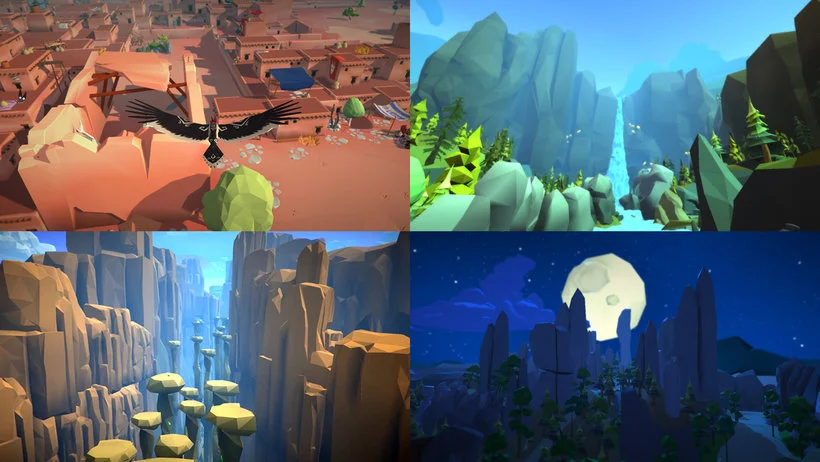

What is the environment concept art?
Environment concept art refers to the process of creating visual representations or designs of environments for various forms of media, such as video games, films, animations, or other visual projects. It involves the creation of artwork that captures the overall look, mood, and atmosphere of a specific environment or location within the project.
The primary purpose of environment concept art is to establish the visual direction and provide a blueprint for the development of the actual environment within the project. Concept artists use their artistic skills and creativity to translate written descriptions or ideas into visually appealing and compelling artwork. They consider various factors like the setting, architecture, lighting, colors, textures, and overall aesthetics to bring the environment to life.
Environment concept art serves as a visual reference and communication tool for the development team, including artists, designers, and 3D modelers. It helps them understand and implement the desired look and feel of the environment. Concept art can range from rough sketches and initial ideation to highly detailed and polished illustrations, depending on the project’s requirements.
By creating environment concept art, artists can explore different design possibilities, experiment with visual elements, and convey the intended mood and atmosphere. It serves as a foundation for the production pipeline, guiding the creation of 3D models, textures, lighting setups, and other elements necessary to bring the environment to fruition.
Overall, environment concept art plays a crucial role in the visual development process, aiding in the creation of immersive and visually captivating environments that enhance the storytelling and overall experience of a project.
What are the types of environment concept Art?
There are several types of environmental concept art that concept artists create to depict different aspects of an environment. These types include:
- Mood Boards: Mood boards are a collection of images, textures, colors, and other visual references that capture the desired mood, tone, and atmosphere of an environment. They help set the overall visual direction and serve as an inspirational starting point for the concept art process.
- Thumbnail Sketches: Thumbnail sketches are quick, small-scale drawings that explore various composition and design ideas for an environment. They are often rough and loose, allowing artists to generate multiple concepts and variations before refining them further.
- Keyframes: Keyframes are detailed illustrations or paintings that depict significant moments or scenes within an environment. They are used to showcase important visuals, storytelling elements, or dramatic moments that convey the essence of the environment.
- Matte Paintings: Matte paintings are highly detailed and realistic paintings or digital compositions that blend 2D and 3D elements seamlessly. They are used to create complex and expansive environments that may be impractical or costly to build physically. Matte paintings are often employed in film and animation to establish large-scale or fantastical settings.
- Layouts and Set Designs: Layouts and set designs focus on the spatial arrangement and structure of an environment. They provide a blueprint for constructing physical or digital sets, including the placement of objects, props, and architectural elements within the space.
- Color Scripts: Color scripts are sequential illustrations that showcase the color and lighting progression throughout a narrative or environment. They help establish the emotional tone, time of day, and overall color scheme for different parts of the environment.
These various types of environmental concept art serve different purposes and contribute to the overall visual development and realization of an environment. They provide a visual guide for the production team, assisting in the creation of detailed 3D models, textures, lighting setups, and other elements that bring the environment to life in a cohesive and visually appealing manner.
Keyframe
Keyframe refers to the illustration of a “key” scene in a movie, game, or novel that is supposed to convey that scene’s general feel and style. Keyframes are known to be outstanding and unique, so it would be nice to have a keyframe in your portfolio too!
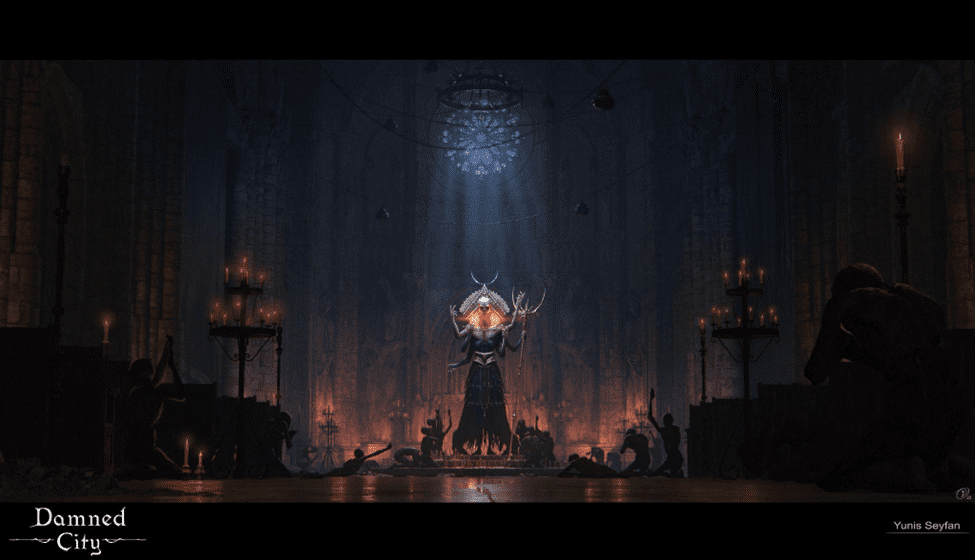

Layout
Layout is designed to show the technical layout of a scene. Layout mostly has a practical purpose.
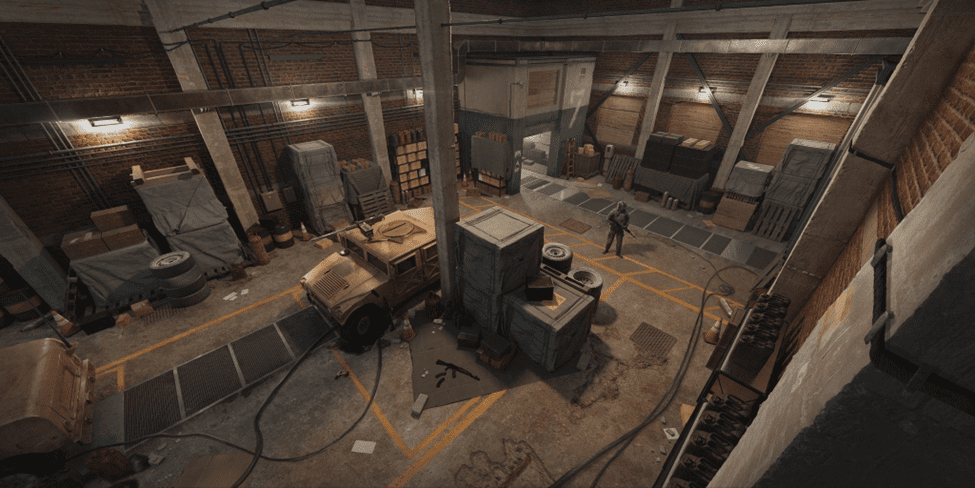

Environment concept art
Environment concept art is basically a balance between both storytelling and layout. It’s the most well-rounded kind of concept art and the best one you can work on for your portfolio.
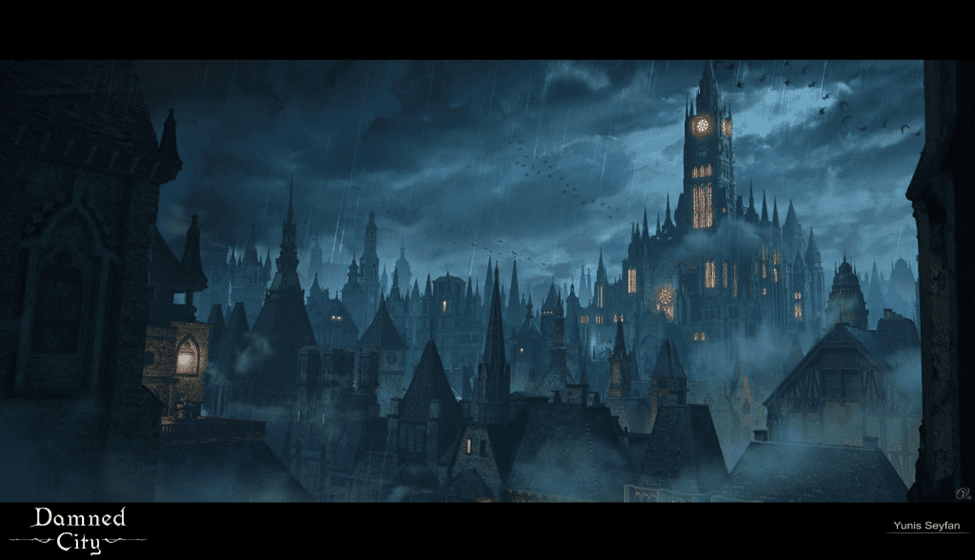

What is an example of environment concept art?
These various types of environment concept art serve different purposes and contribute to the overall visual development and realization of an environment. They provide a visual guide for the production team, assisting in the creation of detailed 3D models, textures, lighting setups, and other elements that bring the environment to life in a cohesive and visually appealing manner.
An example of environment concept art is the concept artwork for the video game “The Legend of Zelda: Breath of the Wild.” The game features a vast and immersive open world filled with diverse landscapes, including lush forests, rugged mountains, serene lakes, and ancient ruins. The environment concept art for this game showcases the visual design and atmosphere of these different locations.
The concept art depicts the stunning vistas, intricate details, and imaginative structures that make up the game’s environments. It showcases the vibrant colors, unique architectural elements, and natural landmarks that contribute to the game’s immersive world. The concept artists use various techniques to convey the mood and ambiance of each location, whether it’s a tranquil meadow, a mysterious cave, or a towering mountain range.
The environment concept art serves as a visual guide and reference for the game developers, providing them with a clear vision of how the environments should look and feel. It helps establish the artistic direction and sets the tone for the overall game experience. The concept art not only influences the aesthetics of the game but also plays a crucial role in storytelling and creating a sense of exploration and wonder for players.
Challenges Faced by Environmental Concept Artists
Environmental concept artists navigate a unique set of challenges in their creative process, demanding a delicate balance between imagination and practicality. One significant challenge is the need to convey a strong sense of atmosphere and mood while adhering to the project’s overarching narrative. Striking this balance requires a deep understanding of environmental storytelling and the ability to evoke emotions through visual elements. Additionally, environmental concept artists often grapple with the challenge of creating original and innovative designs that remain both aesthetically pleasing and functional within the context of the project.
Collaboration with other team members, such as level designers and art directors, can introduce challenges related to aligning individual artistic visions with the overall project goals. Overcoming these challenges requires adaptability, effective communication, and a keen awareness of the project’s thematic and stylistic requirements.
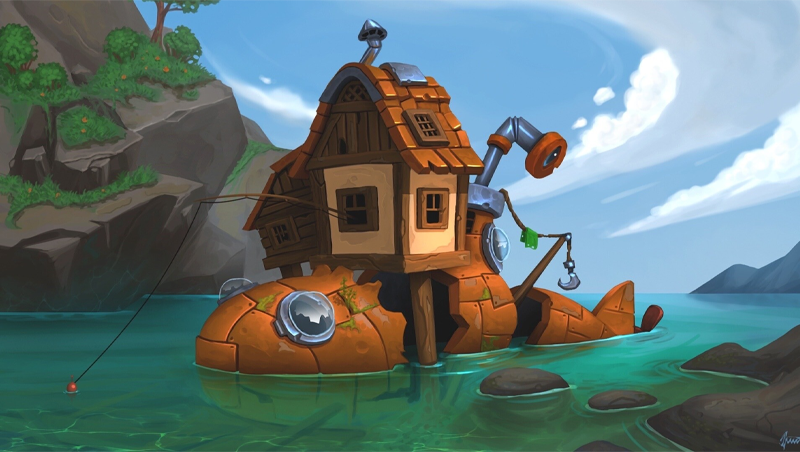

Common Mistakes to Avoid in Environment Concept Art
Avoiding common mistakes is essential for environment concept artists to deliver high-quality and impactful visuals. One prevalent mistake is neglecting the importance of thorough research and reference gathering. Failing to understand the environmental context, whether historical, cultural, or geographical, can compromise the authenticity of the concept.
Another mistake to avoid is overcomplicating designs, as cluttered or overly intricate visuals may distract from the intended narrative. Inconsistent lighting and perspective can undermine the overall coherence of the concept, highlighting the importance of maintaining visual harmony. Additionally, overlooking the scalability and adaptability of the concept for different platforms or media can lead to challenges during the later stages of production. By acknowledging and rectifying these common pitfalls, environment concept artists can enhance the effectiveness of their work and contribute to the success of the overall project.
Environment Concept Art Pipeline
The environment concept art pipeline outlines the systematic process through which ideas evolve from initial conception to the final realization of a visual concept. It typically begins with a thorough understanding of the project’s requirements and objectives, followed by extensive research and reference collection. Sketching and ideation come next, allowing the artist to explore various visual possibilities and refine the chosen direction. Once the concept takes shape, the artist proceeds to create detailed illustrations, incorporating feedback from team members and stakeholders.
Collaboration with other disciplines, such as 3D modelers and texture artists, is crucial in ensuring the seamless integration of the concept into the overall production pipeline. The final stage involves the delivery of polished concept art that serves as a blueprint for subsequent stages of development. A well-structured and collaborative environment concept art pipeline streamlines the creative process, fostering efficiency and coherence in the realization of virtual worlds and settings.
The Difference Between Environmental Concept Art and Other Forms of Concept Art
Environmental concept art focuses specifically on depicting the settings, landscapes, and environments within which a game, film, or other visual media takes place. Unlike character or prop concept art, which primarily centers on individual elements within a scene, environmental concept art encompasses the broader context and atmosphere of a given location.
It involves conveying the mood, tone, and overall aesthetic of environments, as well as establishing the spatial layout and architectural design. Environmental concept art serves as the blueprint for world-building, guiding the creation of immersive and believable fictional worlds that captivate audiences.
The Responsibilities and Tasks of an Environmental Concept Artist
Environmental concept artists play a pivotal role in the pre-production phase of visual media projects, collaborating closely with art directors, level designers, and other stakeholders to bring virtual worlds to life. Their responsibilities include visualizing and designing diverse environments, ranging from fantastical landscapes to futuristic cityscapes, while adhering to the artistic vision and thematic direction of the project. Environmental concept artists conduct extensive research to inform their designs, drawing inspiration from real-world locations, architectural styles, and historical references.
They employ various artistic techniques, such as digital painting, matte painting, and photo bashing, to create compelling and visually striking concept artwork that serves as a foundation for the final in-game or cinematic environments.
Additionally, environmental concept artists may contribute to the development of mood boards, color palettes, and visual style guides to ensure consistency and cohesion across all aspects of environmental design. Through their creativity, expertise, and attention to detail, environmental concept artists play a crucial role in shaping the immersive worlds that captivate audiences in the realm of entertainment media.
Why do we need concept landscapes and environments?
Concept landscapes and environments serve several essential purposes in the development of video games, films, animations, and other visual media:
- Visualizing Ideas: Concept landscapes and environments help artists and designers visualize the setting and atmosphere of a project before production begins. They provide a blueprint for the world-building process, allowing creators to explore different themes, moods, and visual styles.
- Establishing Tone and Atmosphere: Landscapes and environments set the tone and atmosphere of a scene, conveying mood, emotion, and narrative context to the audience. Whether it’s a serene forest, a bustling cityscape, or a desolate wasteland, the environment plays a crucial role in shaping the viewer’s perception and emotional response.
- Guiding Production Decisions: Concept landscapes and environments inform production decisions related to art direction, level design, lighting, color palette, and visual effects. They serve as a reference point for artists, modelers, and level designers, guiding the development process and ensuring consistency and coherence across the project.
- Pitching and Presenting Ideas: Concept landscapes and environments are often used to pitch and present ideas to stakeholders, clients, and investors. By showcasing compelling visuals and immersive worlds, concept artists can effectively communicate their vision and garner support for the project.
- Inspiring Creativity: Landscapes and environments inspire creativity and imagination, providing artists and designers with a rich visual tapestry to draw inspiration from. They encourage exploration, experimentation, and innovation, fueling the creative process and pushing the boundaries of artistic expression.
In summary, concept landscapes and environments play a vital role in the pre-production phase of visual media projects, serving as a foundation for world-building, storytelling, and artistic exploration.
What makes a great environmental concept artist?
A great environmental concept artist possesses a unique blend of artistic talent, technical skill, and creative vision. Here are some qualities that contribute to their success:
- Strong Artistic Skills: A great environmental concept artist demonstrates proficiency in traditional and digital art techniques, including drawing, painting, composition, and color theory. They have a keen eye for detail, form, and perspective, allowing them to create immersive and visually stunning landscapes and environments.
- Creative Vision: Environmental concept artists possess a vivid imagination and the ability to conceptualize unique and compelling worlds. They can translate abstract ideas and narrative concepts into tangible visual representations, infusing their environments with depth, personality, and storytelling potential.
- Technical Proficiency: Environmental concept artists are proficient in digital art software such as Adobe Photoshop, Autodesk Maya, or Blender. They understand the technical aspects of environment design, including 3D modeling, texturing, lighting, and rendering, allowing them to create detailed and realistic landscapes and environments.
- Collaborative Spirit: Great environmental concept artists collaborate effectively with other members of the production team, including art directors, designers, and modelers. They can interpret feedback, incorporate changes, and communicate their ideas clearly and concisely, ensuring alignment with the project’s artistic vision and goals.
- Adaptability and Flexibility: Environmental concept artists are adaptable and flexible, capable of working across different artistic styles, genres, and mediums. They can adjust their approach to meet the unique requirements and constraints of each project, whether it’s a fantasy world, a sci-fi universe, or a historical setting.
- Passion and Dedication: Above all, great environmental concept artists are passionate and dedicated to their craft. They are driven by a love for storytelling, world-building, and visual expression, investing time and energy into honing their skills and pushing the boundaries of their creativity.
By embodying these qualities, environmental concept artists can create immersive and captivating landscapes and environments that captivate audiences and bring imaginary worlds to life.
What is the goal of environment concept art?
The goal of environment concept art is to visually communicate and capture the essence of a specific environment or location within a larger creative project, such as a video game, film, or animation. It aims to provide a clear and compelling visual representation of the intended atmosphere, mood, and overall design of the environment.
One of the primary objectives of environment concept art is to inspire and guide the development team in creating cohesive and immersive worlds. It helps establish the visual direction and provides a reference for artists, level designers, and other team members involved in the production process. By presenting a detailed and evocative depiction of the environment, concept artists ensure that everyone involved shares a common vision and understanding of the intended look and feel.
The goal of environment concept art is also to elicit an emotional response from the audience or player. It aims to create a sense of wonder, intrigue, or even fear through its visual storytelling. The use of color, lighting, composition, and other artistic elements helps convey the desired mood and atmosphere of the environment. Whether it’s a serene and peaceful landscape, a bustling urban cityscape, or a hauntingly dark and mysterious setting, the concept art strives to evoke specific emotions and immerse the audience in the world being depicted.
Another important aspect of environment concept art is its role in world-building and narrative development. It helps shape the context and backstory of the environment, providing visual cues and storytelling elements that enhance the overall narrative of the project. Concept artists often collaborate closely with writers, directors, and game designers to ensure that the visual design aligns with the intended story and thematic elements.
Now the question is, what are the things to consider when creating an environment concept art?
The first step is to know the backstory that led to creating the environment you will draw. This backstory should be so evident in the final art that the audience can decide what it’s about without reading any text. For instance, if you want to create a concept art set in a post-apocalyptic world, you need to include certain elements and details that show a world you’re familiar with but not in its natural state; it has been ruined.
Depicting the Statue of Liberty – a typical element – that has been broken in half – a symbolic catastrophe – is a simple example of conveying post-apocalyptic imagery. Depicting overgrown vegetation or military equipment in the middle of a city is some of the more general imagery used for this purpose.
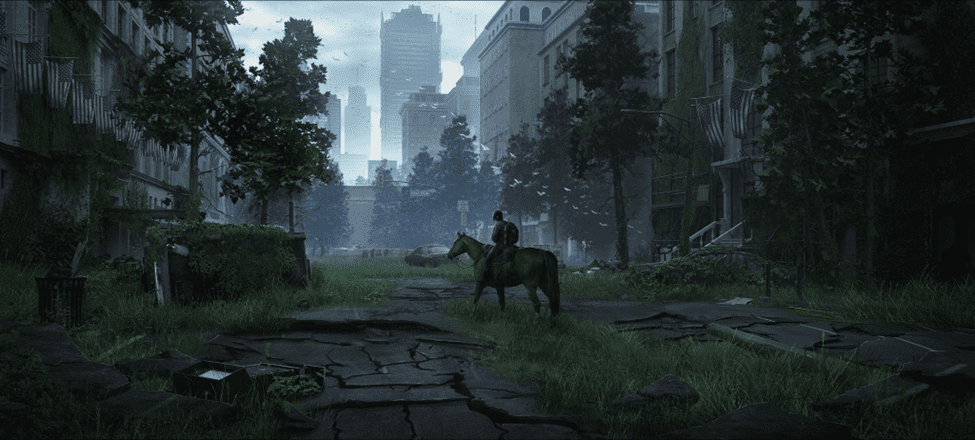

The second step is to carefully consider why every object and element is placed inside the art. Remember: a picture speaks a thousand words, so your concept art should do what a thousand words of description is supposed to do. There’s a whole sub-category dedicated to designing objects called prop design. Prop design is based on shape and design language. It also helps you understand which things should be included in a piece of art and how they enhance it. Shape language is like language itself; when you know the basics, you can talk; but when you get to know it deeply, you can create poetry with it. If I want to explain it in a short and easy form, I would say it’s the knowledge behind the meaning of each shape. For example, sharp shapes and edges usually communicate feelings of danger and hostility; on the other hand, round shapes are considered friendly shapes in our minds.
The third step is composition, the art of combining and arranging different elements in a picture. The composition follows two principal goals:
- Composition should keep the image vivacious so that when someone looks at it, they don’t get bored or overwhelmed
- Composition should guide the eyes of the audience toward the image’s focal point, the point we want the audience to pay attention to the most
There are a couple of ways to do that, for example:
- Color: By using a unique color composition near the focal point, you can attract attention, especially by using colors that complement or contrast each other.
- Lightning: Lighting is the most obvious way to attract attention. By using the light in your artwork, you can move and guide the eyes of the viewer to where you want.
Composition itself has different ways of expression, and each one of them is used for different purposes. For example, looking at a person or a building from below creates a sense of power and awe. To achieve this vibe, you need to follow a triangle-shaped composition. Here are the most used and well-known compositions that you can see in almost every artwork :
- Rule of thirds
- Golden ratio
- Triangle
- Centralized
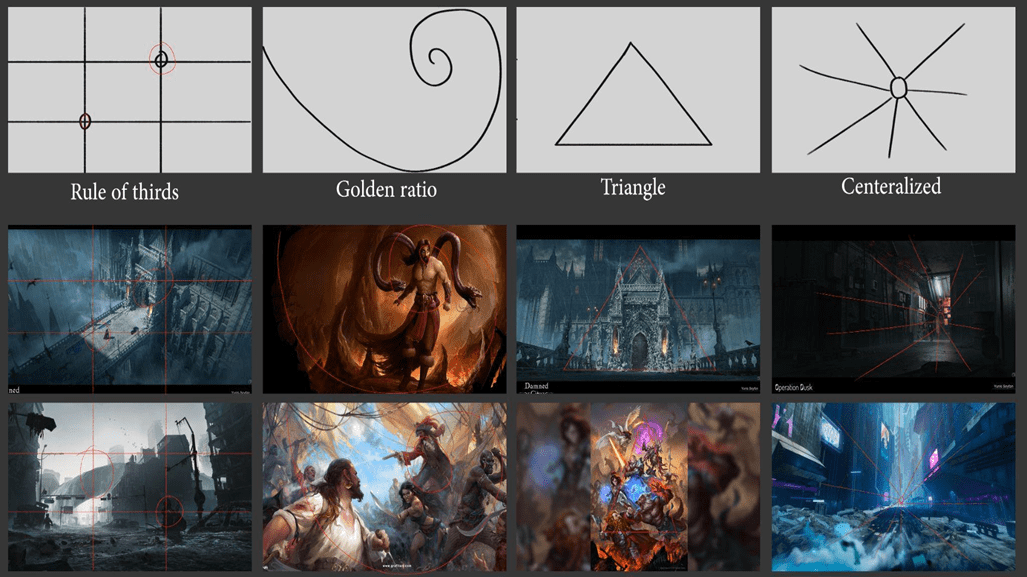

One of the crucial aspects of environment concept art that many people – especially rookies – don’t pay enough attention to is the mood. Mood can enhance and energize your frames so much that even if you fall short in other aspects – like composition, shape language, prop design, etc. – mood can make up for it.
Mood, as the name suggests, is about the image’s general feeling, and it’s the most intuitive aspect of the concept art. Mood can be created by combining different factors, like color, light, or fog. If you’re looking for inspiration, search “Color keys” on Google to get acquainted with the work of great artists when it comes to creating moods.
If you want to create a portfolio that stands out, it’s important to consider all the points mentioned here. The people who consider your portfolio have an eye for natural talent and passion. Still, due to experience and exposure to many artworks, they also have an eye for all the little technical details that only artists who bothered to educate themselves would include in their work.
FAQ
Why is environmental concept art important?
Environmental concept art is critical because it provides the visual foundation for creating immersive and compelling worlds. These artworks help translate the creative vision of writers and directors into tangible visuals. They guide the entire production process by setting the tone, style, and atmosphere of the environment, ensuring consistency and alignment with the narrative.
What are the skills required of an environment concept artist?
Successful environmental artists possess a range of skills. These include the ability to sketch and draw well, a deep understanding of perspective to create convincing spatial relationships, an understanding of color theory to set the mood, and strong storytelling skills to convey a sense of narrative through visuals.
How does environmental concept art contribute to storytelling?
Environmental concept art plays a vital role in storytelling by visually communicating important elements of the narrative. It establishes the world's context, historical background, and emotional tone. The visual cues within concept art can evoke specific emotions, drawing the audience into the story's universe and enhancing their connection to the characters and events.
Are traditional art skills necessary for digital environment concept art?
While not required, traditional art skills often enhance digital environment concept art. Knowledge of traditional techniques such as sketching, painting, and composition can be effectively translated to digital platforms. This foundation helps artists master the basics of visual storytelling and aesthetics, which benefits their digital artwork.
What tools do environmental artists use?
Environmental artists primarily use digital tools and software to create their art. Popular programs include Adobe Photoshop, Procreate, and 3D modeling software such as Blender or Maya. These tools allow artists to experiment with color, texture, lighting, and composition to bring their envisioned environments to life.
Do environmental artists collaborate with other professionals?
Yes, collaboration is a critical aspect of creating environmental concept art. Concept artists work closely with other professionals such as game designers, level artists, and art directors. This collaboration ensures that the visual designs are in line with the overall vision of the project, maintaining a cohesive and immersive experience for the player or viewer.
What is the process of creating environmental concept art?
The process typically begins with research to gather references and inspiration. Artists then create thumbnail sketches to explore compositional options before refining their chosen concepts. Color studies help establish the desired atmosphere, and detailed renderings bring the environment to life. The iterative process includes feedback and adjustments to ensure the final artwork meets the intended vision.
What makes a great environment concept artist?
A great environment concept artist possesses a unique blend of artistic talent and technical skill. They excel in conveying mood, atmosphere, and emotion through visuals, allowing them to tell stories with landscapes. Attention to detail, strong perspective skills, and proficiency with digital tools are crucial. Adaptability is also key, as these artists often collaborate closely with other creatives to bring their visions to life. Ultimately, what sets a great environment concept artist apart is their ability to transport audiences to new worlds and make them emotionally invest in the settings they create, making them indispensable in visual storytelling.
